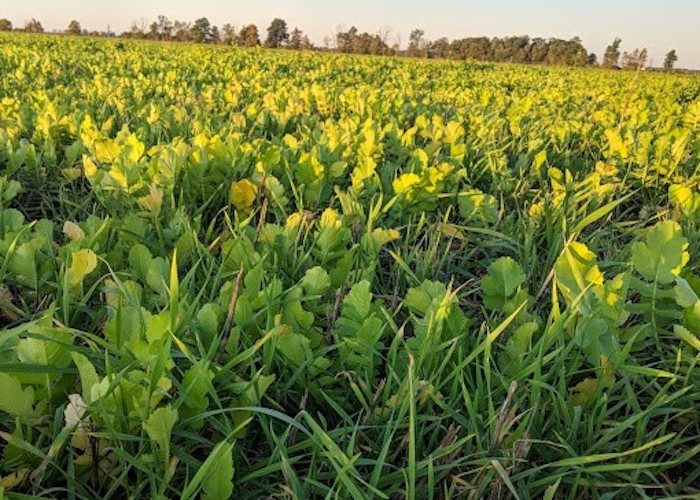By James Hoorman, Hoorman Soil Health Services
Farmers are working to wrap up wheat harvest and considering what to do next. Some will decide to do nothing, others may consider planting another crop, either soybeans or a cover crop. Double-crop soybeans do best when soil is moist and temperatures do not get too hot. Cover crops give a farmer a little more flexibility, especially when planted in mixtures. Research in North Dakota, shows that even with minimal moisture, cover crop mixtures can flourish.
If cover crops are to be planted, there are several considerations. First, do you leave the straw and the biomass, or do you harvest it? While many farmers want to conserve their carbon, the high carbon to nitrogen (C:N) ratio of straw can reduce new cover crop plant growth. For soybeans, it does not seem to matter, since they make their own N. Harvesting straw can be an option for extra income, but the nutrients removed in straw need to be adequately compensated. Wheat straw has roughly about 9-12# N, about 1.5# actual phosphorus (P), and roughly 30# of actual potassium (K) per ton. At $1 for N, $.60 for P, and $.40 for K, a ton of wheat straw has about $25 of macro-fertilizer nutrients in it.
Second, what is the next crop? Corn benefits from planting legumes (cowpeas, winter peas), clovers (crimson, Balansa, Red) or vetches (hairy, common). Generally, when its hot and dry, cowpeas do better while winter peas like cooler temperatures and more moisture. Soybeans, benefit from grasses like cereal rye, barley, and oats which supply more P with their fibrous roots.
Next, when and how will the cover crop be planted? Planting right after wheat harvest allows plants to gain more biomass before it freezes. However, moisture and weed seed germination can be issues. Planting early allows many summer annuals to be included in cover crop mixtures before a frost. Sunflower, buckwheat, Sorghum species all can be planted in early summer and benefit from the sunlight. To reduce weeds; cereal rye, radish, and sorghum are known to be good weed fighters. If planting later in the summer (August), farmers have the option of letting the weeds grow first, then spraying with a herbicide to terminate weeds. The later cover crops are planted, the less benefit there are to planting summer annuals. In summer, due to moisture restrictions, drilling cover crops is really the best option, broadcasting is not recommended. Broadcasting seed in the summer runs the risk of not enough rain for moisture; plus voles, earthworms, and even slugs like to consume broadcast seed.
Farmers may not be sure when they will plant their cover crops. In this case, hedge your bets by buying seed in bulk and mixing your own seed. Farmers can use two totes stacked on top of each other to mix their own seed. Weigh out or put in each variety in layers, add rhizobia inoculant if needed, then open the hatch about .5 inches. The seed/inoculant will slowly mix together and repeat three times. Mixing your own seed can save on mixing costs and avoid planting a species that will freeze out early. Make sure you use the right inoculant for the legumes, clovers, or vetches that are planted. Keep the inoculant cool and out of sunlight. Most cover crop seed inoculant will only survive 12 to 48 hours, so put it on right before planting.
On the drill, make sure the disc blades are sharp when planting into wheat stubble to avoid hair pinning. Calibrating your drill is beneficial to having adequate seed and not too much left over. If you have a mixture this is often used, remember to take notes and write down the settings for next year. When drilling cover crops, try to keep the boxes relatively full and avoid bouncing. Generally, it pays to slow down near the end because as seed mixtures runs out, bouncing may cause seed to separate.
Farmers often agonize over what depth to plant cover crop seed? If the seed size is similar, it is not much of an issue, but with several cover crop seeds in a mixture, how do you decide a seeding depth? Small seeds should be plant shallow while large seeds can/should be planted deeper to moisture. For small seed, use a clover box or small broadcast seeder if available. If all the seed is mixed together, go with an intermediate seed depth (.5 to.75 inches). Bigger seeds help smaller seed come up. If farmers are in the Ohio H2O program, consult NRCS Appendix A on Cover Crops because at least 50% of cover crop mixtures need to overwinter to qualify for payment.





Post a comment
Report Abusive Comment